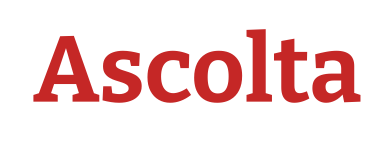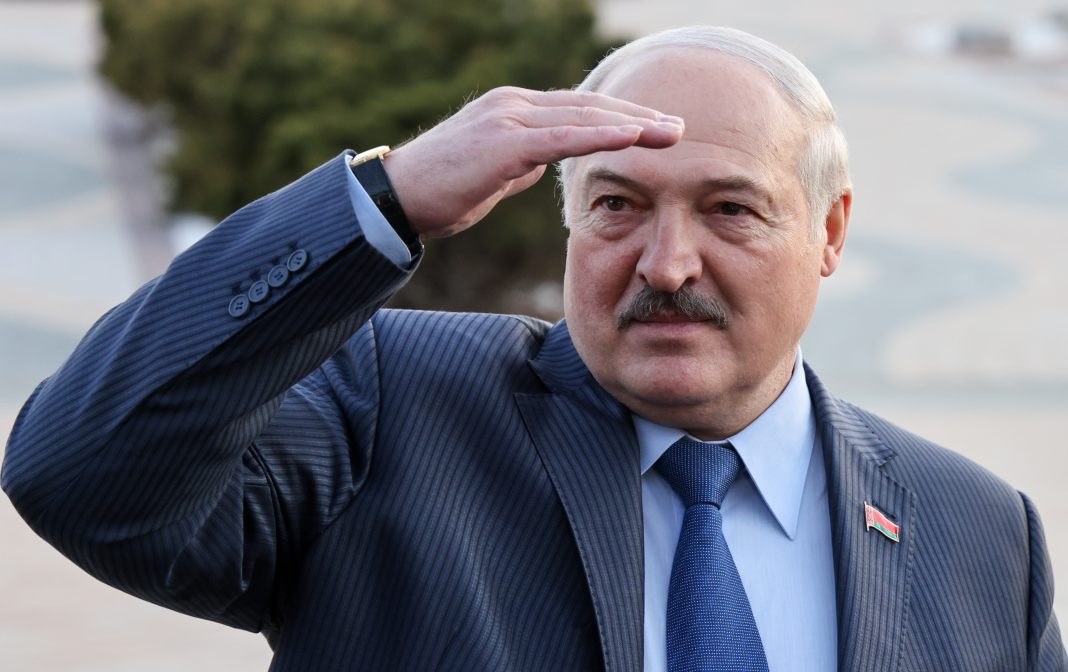Against the backdrop of Alexander Lukashenko’s next visit to Russia and his participation in the Supreme State Council of the Union State, which is regularly held with the involvement of the two presidents, public interest in the integration processes between Moscow and Minsk has noticeably renewed.
Despite the integration processes being actively carried out throughout 2023, they received little publicity in the media. Moreover, against the backdrop of rumours about the freezing of the Union State idea, spread by several sources, many analysts began to view relations between Russia and Belarus through the prism of a cooler and more cautious interaction.
It is worth recalling that in our previous materials, we have repeatedly predicted the possibility of completing the full implementation of the Union State at the beginning of 2024. Recent activities observed at different levels demonstrate that such a scenario has every chance of being realised.
At the same time, Alexander Lukashenko does not stop trying to form more favourable positions on a number of economic and political issues. In the same context, one could observe his regular friction with the leaders of Russian regions, who, over the past two years, have actively visited Minsk to discuss possible cooperation on specific issues.
In this article, Ascolta analyses the current situation around the Union State and examines the prospects for further integration through the prism of relationships at the regional level.
This Content Is Only For Subscribers
In the context of deepening relations between the Russian Federation and the Republic of Belarus, it is necessary to consider in more detail integration actions at the level of individual regions and constituent entities of the Federation in interaction with state structures of Belarus. Since 2014, an instrument such as the Forum of Regions of Russia and Belarus has been actively used (the eleventh forum was held on January 25, 2024). Integration processes significantly intensified after the start of the full-scale aggression of the Russian Federation against Ukraine. For Russia, direct contacts between Minsk and individual regions were seen as a form of closer involvement of Belarus in all Russian processes, including socio-economic ones. After the meeting of Vladimir Putin and Alexander Lukashenko in St. Petersburg (July 25, 2022), it was decided to strengthen the interaction between Russia and Belarus at the level of state leadership and the regional level.
In Belarus, the concept of “governor’s Thursday” even arose. Most often, meetings of Alexander Lukashenko with the governors of Russian regions and heads of republics take place on Thursdays, and they receive serious attention from the media.
On July 28, 2022, the governor of the Perm region, Dmitry Makhonin, arrived in Minsk (the governor has Belarusian roots – his ancestors were expelled to Perm from the Mogilev region during the Stalinist repressions). The parties stated common interests – primarily among the Belarusian side. Trade turnover between Belarus and enterprises of the Perm region in 2021 amounted to about $500 million. The region is one of the most industrially developed in Russia and ranks 10th in the economic potential index. Makhonin brought representatives of ten companies to Minsk – from the production of personal protective equipment to IT specialists. The conversation was primarily about cooperation with Belarusian enterprises (especially in mechanical engineering). Perm has expressed interest in purchasing elevator equipment made in Belarus. They also discussed the opening of direct flights between Minsk and Perm.
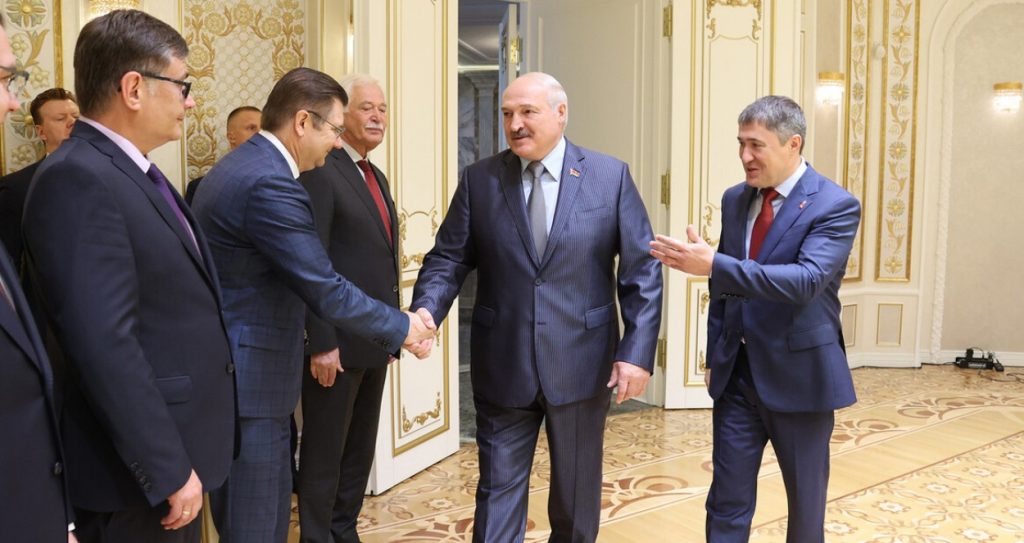
On October 8, 2022, the Governor of the Murmansk Region, Andrei Chibis, visited Minsk. Lukashenko stated, “Based on the results of the first half of the year, trade volume increased by almost 23%, primarily due to supplies from the Murmansk region: imports increased by 35%, and Belarusian exports fell by 20%: “We can level out the imbalance, and, most importantly, there is something to level out.” The Belarusian president did not hide that Lukashenko’s meeting with Chibis was Putin’s initiative (Lukashenko’s direct speech: “The Russian President also supports cooperation between Belarus and the Murmansk region in logistics. He asked me: “Do you want to work in the Murmansk region too?” I say: “Certainly. They don’t put all their eggs in one basket.” He says: “We are very interested in this and support it”).
The main interest shown by the governor of the Murmansk region concerned the supply of vehicles from the Minsk Automobile Plant for the needs of the region’s mines. It was about purchasing 45 cars. An essential issue for Belarus is the reorientation of part of the export cargo, particularly potash fertilisers, to the ports of the Murmansk region.
On October 15, 2022, the Governor of the Chelyabinsk Region, Alexey Teksler, visited Minsk. The talk was about helping Russian enterprises in the process of import substitution and cooperation in the engineering industry. We agreed on closer cooperation between the Chelyabinsk Tractor Plant, the Minsk Tractor Plant, the Minsk Automobile Plant (MAZ cars), and the Chelyabinsk Automobile Plant (Ural cars). According to available data, all four enterprises are planned to be transferred to the mode of maximum assistance in producing military equipment.
On April 13, 2023, Rustam Minnikhanov visited Minsk. His visit was connected with a personal request from Vladimir Putin. The discussion was primarily about the possibilities of access for the Russian Federation (and Tatar companies) to the production of potash fertilisers on the territory of Belarus (no agreement was reached on this issue). Issues of trade and the development of cooperation in the field of IT technologies, industry, and construction were also discussed.
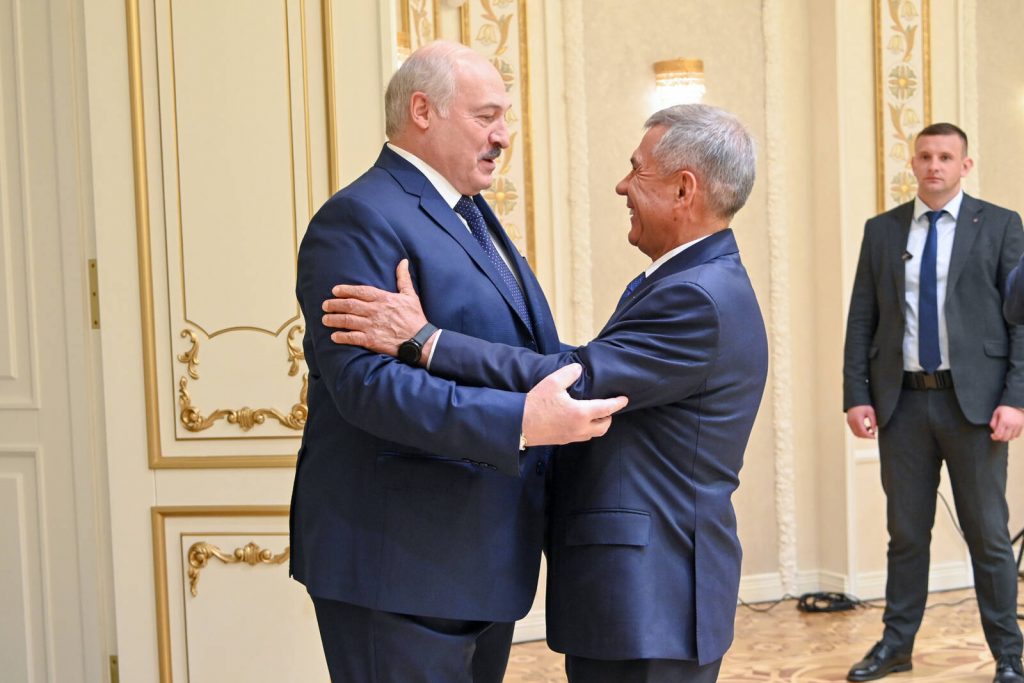
On April 18, Lukashenko met with the “head” of the “DPR”, Denis Pushilin. The Deputy Head of the Russian Presidential Administration, Sergei Kiriyenko, organised this meeting. They talked about possible assistance to Donbas from Belarus. But the real significance of this meeting was to “link” Lukashenko to the Donbas scenario and show that Belarus actually recognised the “entry” of the Donetsk region into the Russian Federation.
On April 20, 2023, Lukashenko received the Governor of St. Petersburg, Alexander Beglov. Alexander Lukashenko said during the meeting: “We have a lot of work ahead of us to strengthen our union of Belarus and Russia, which today is a stronghold of freedom and truth in the CIS and beyond. And the regions of the Russian Federation make a huge contribution to strengthening our allied relations. I often say: if there weren’t our ties with the regions of Russia, there wouldn’t be current relations.” The main interest Belarus shows in St. Petersburg is the possibility of using port facilities and capacities in the Baltic.
On May 16, 2023, the governor of the Vladimir Region, Alexander Avdeev, visited Minsk. During the meeting, it was emphasised that trade turnover between the Vladimir region and Belarus in 2022 exceeded $400 million (20% more than in 2021). Again, we were talking about cooperation in IT technologies and defence orders.
On June 5, the governor of the Kaliningrad region, Anton Alikhanov, visited Minsk (this was Alikhanov’s third visit to Belarus in the governor status). First, the issues of the blockade of transport corridors by Lithuania and Latvia were discussed. From Russia’s point of view, Alikhanov’s visit was symbolic: the problem of confrontation with the Baltic countries over the Suwalki corridor was on the agenda, and Alikhanov’s meeting with Lukashenko was supposed to become a kind of element of playing on nerves. During the meeting, Lukashenko said: “The unprecedented attempt made by the West in 2022 to limit our communication with you and the free movement of goods by rail and road from Russia and Belarus was doomed to failure. No matter how they try to separate us with artificial barriers, it will not work. But it’s dangerous. This is already an economic war. And not only economic. Which these famous madmen are trying to tell us. Then, let them not be offended. Moreover, we are not threatening anyone. We are simply looking after our interests – Belarus and Russia. It’s still difficult, but I manage to endure all these antics. But this cannot continue indefinitely. And therefore the leadership of the Baltic states should understand this very well. We are overcoming these difficulties.”
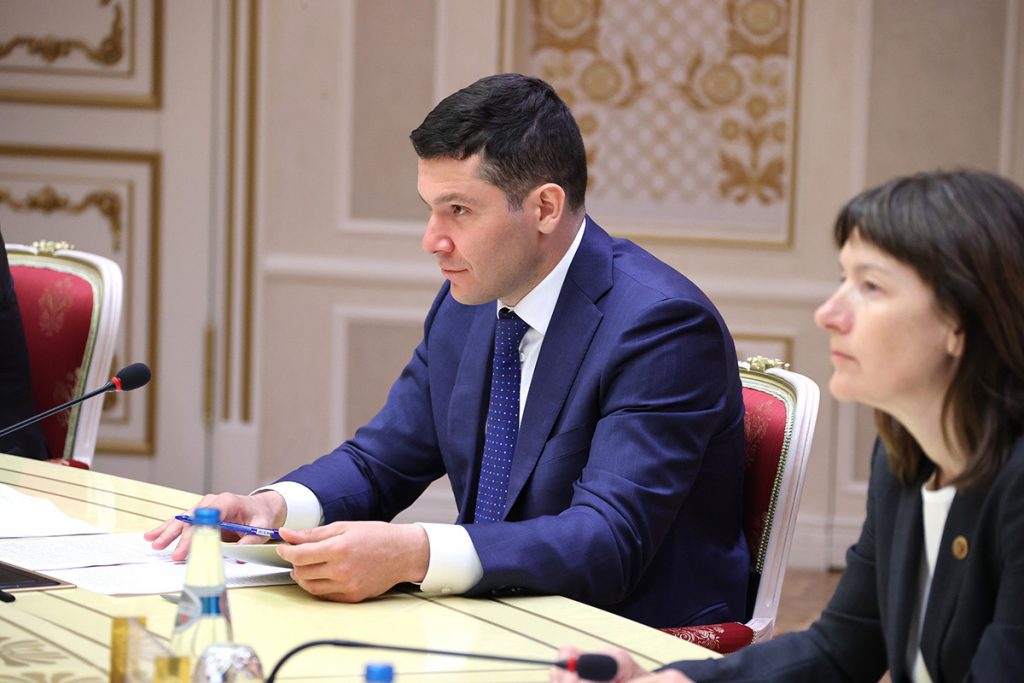
The next day, June 6, Lukashenko received the Governor of the Primorsky Territory, Oleg Kozhemyako. During the meeting, issues related to Russian-Belarusian-Chinese relations and food supplies from Belarus to the Far East were discussed.
On June 28, during the Tenth Forum of Regions of the Russian Federation and Belarus in Ufa, Lukashenko addressed the participants with a welcoming speech: “Even in the most difficult times for Belarus and Russia, contacts at the regional level were actively developing. This helped us survive the collapse of statehood and the severance of established economic ties after the collapse of a great country. And now, strong relations help us withstand a new blow from the West on all fronts: economic, political, ideological, informational, cultural and others… I believe that the decision of the Russian side to expand the geography of forums, bringing them closer to various constituent entities of the Russian Federation, is correct. It makes it possible to maximise the advantages of their regions and demonstrate their economic potential. It is important that even thousands of kilometres from our country, Russians know even more about Belarus and see the prospect of the Belarusian-Russian partnership.”
On August 15, Lukashenko held a working meeting with the governor of the Tomsk Region, Vladimir Mazur. He noted that the Tomsk region is one of the most important for Belarus strategically. In the first half of 2023, the volume of mutual trade increased by 33% compared to the same period in 2022. But simultaneously, the task was set to increase trade turnover by 2–3 times. Lukashenko, in turn, assured: “I am convinced that together we can create the most advanced technologies, eliminating our dependence on the West. I want to emphasise that we are open to a substantive conversation in all areas of cooperation. If we promise and agree on something, the Belarusians will fulfil it.”
On August 29, a meeting took place with the governor of the Tambov Region of the Russian Federation, Maxim Egorov. It was noted that trade turnover between Belarus and the Tambov region amounted to $178 million. The main dialogue was conducted around issues of joint projects and industrial cooperation. Lukashenko stated, “Time forces us to more actively move from simple commodity exchange to the development of production and cooperative cooperation, and to concentrate efforts on import substitution. This will ensure technological independence and security.” The supply of Belarusian equipment, including passenger transport, was discussed (“We are also ready to supply passenger equipment, including gas-powered buses, trolleybuses, and electric buses with the required characteristics”). An option for cooperation based on JSC Tambovspetsmash (in the interests of the defence industry) was considered. The exchange of experience in modern agricultural technologies and processing of farm products, on selection work and breeding issues, and training of qualified personnel for the agro-industrial complex was recognised as valuable. It was also decided to exchange students and experience in implementing educational programs.
On September 19, Lukashenko met with the governor of the Krasnodar Territory, Veniamin Kondratyev. Lukashenko and Kondratiev have known each other for a long time; they had many meetings. Lukashenko says, “We consider Kuban a key region where we must “ground ourselves.” It was noted that at the end of 2022, trade turnover between the region and Belarus increased by 60% and amounted to $557 million. Kondratyev emphasised his interest in developing relations with such enterprises as MTZ, Pinskdrev, Mogilevliftmash and others. We discussed several cooperation projects in the field of agro-industrial complex.
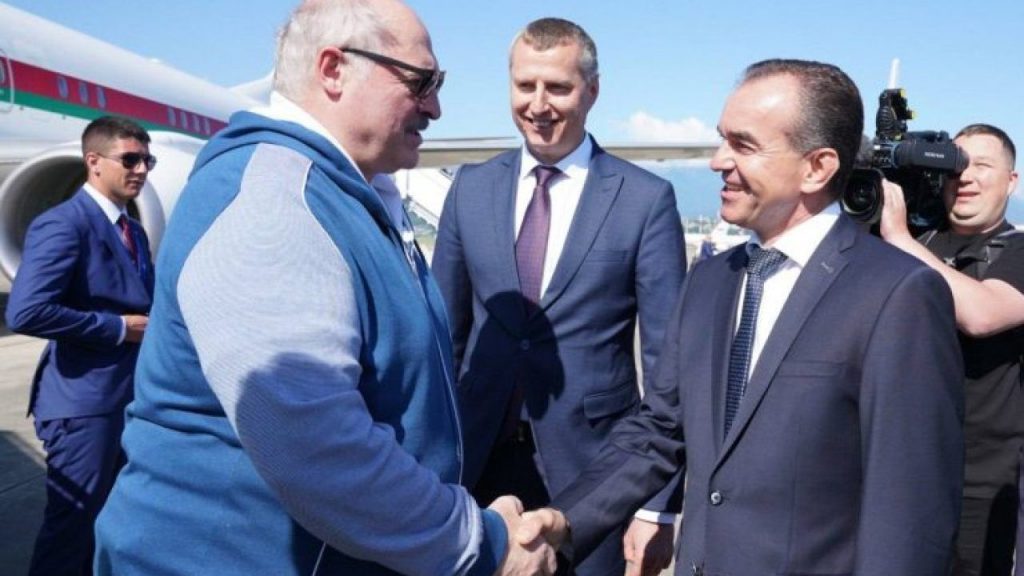
On September 26, Lukashenko met with the governor of the Leningrad Region, Alexander Drozdenko. In 2022, mutual trade between Belarus and the Leningrad region amounted to $834.1 million. At the same time, Lukashenko set the task of raising this figure to a billion dollars. “We would very much like to place a bet in Russia, first of all, on your region. We have exemplary relations with the Leningrad region. And it must be more efficient. During the previous meeting, we outlined a goal – to reach the coveted billion in trade. To achieve this, year-on-year supply volumes will have to increase by about a fifth – by 20 per cent. This task is feasible in the current situation, and we will not limit ourselves to a billion. This is only a conditional guideline for us,” Lukashenko said. He is attracted to the region primarily because of its transport and logistics capabilities, which allow products to be transported abroad by sea. “With your help, we have reoriented logistics, and our manufacturers again have the opportunity to trade in Asia, Latin America, the Middle East and Africa. We will strengthen this direction. For many Western politicians, it was a real discovery that the world is much wider than their narrow ideas about it,” said the President of Belarus.
On October 5, the governor of the Ulyanovsk region, Alexey Russkikh, visited Minsk. Lukashenko spoke with him about the “industrial sector with an emphasis on high-tech technologies,” including cooperation in aircraft manufacturing (aircraft for regional transportation).
On October 9, the governor of the Novosibirsk Region, Andrei Travnikov, arrived in Minsk, accompanied by the head of Russian Export Center JSC Veronika Nikishina. During the meeting, Alexander Lukashenko said: “I am confident that your visit to Belarus will open a new page in cooperation between the Belarusian and Russian regions, and the opportunities here, as you will see for yourself after getting to know our country better, are enormous. The volume of trade transactions last year amounted to almost half a billion dollars. The figure is solid, but we need to figure out why we are noticeably behind last year’s figures today. I propose to work together to balance our trade. There are plenty of directions and opportunities for mutually beneficial cooperation.”
Lukashenko did not hide that in relations with the Novosibirsk region, issues of interaction in the military-technical sphere come to the fore: “There is interaction, plans and projects, but all this, in my opinion, needs to be accelerated and filled with specifics. For example, we can combine our efforts in significant promising areas – artificial intelligence and unmanned aerial systems, taking into account the tasks of import substitution and ensuring technological sovereignty with an eye to rapid development.”
On October 19, the Governor of Mordovia, Artem Zdunov, visited Belarus. In 2022, the parties reached a record trade turnover of almost $90 million. But by the end of eight months of 2023, they significantly exceeded it – the growth rate was nearly 300%, or $115.7 million. “And this is far from the limit. We have enough resources for further development in this regard,” Lukashenko is convinced. He especially thanked the head of Mordovia for the prompt assistance in supplying railway cars for the needs of Belaruskali and other Belarusian enterprises. Lukashenko noted the interest of the Belarusian side in cooperation with the Ruzkhimmash company in the development of foundry production and the production of equipment for the chemical industry. They also discussed Belarus’ readiness to share experience and technologies for using secondary resources, including synthetic RDF fuel, to produce thermal energy.
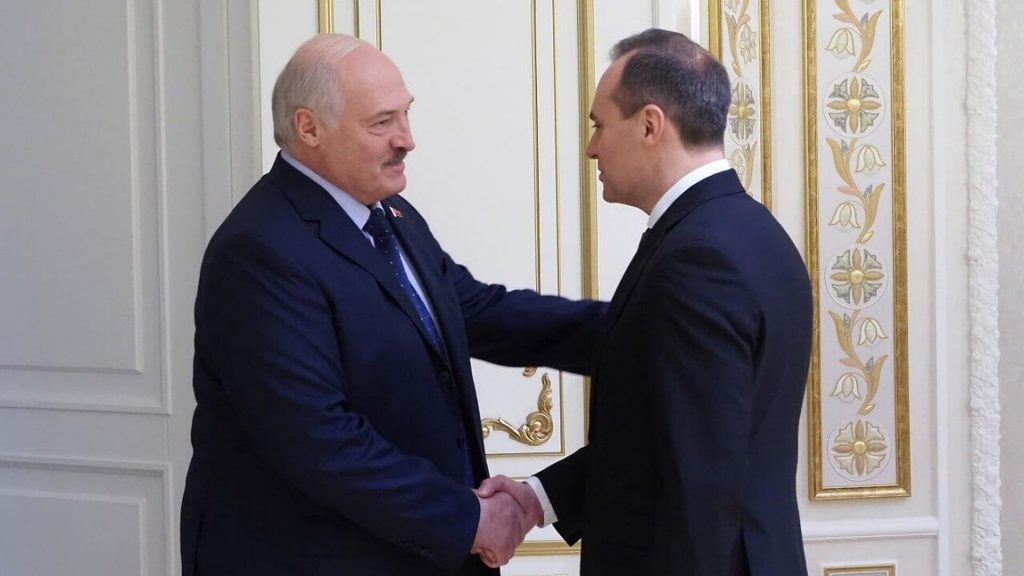
On October 26, Alexander Lukashenko met with the governor of the Vologda region, Oleg Kuvshinnikov (interestingly, Kuvshinnikov resigned from the post of governor four days after the meeting with Lukashenko). During the meeting, Lukashenko stated, “In light of the agreements with the President of Russia, the Government of Belarus received an obvious instruction to work out cooperation projects with the regions of Russia as actively as possible. This activity is already producing results. Based on the results of last year, 2022, record numbers of trade turnover between us were achieved. About 680 million dollars.” Regarding trade turnover, the Vologda region is in 13th place in the ranking of Russian regions. Strengthening cooperation in the following areas was discussed: industrial cooperation, supply of machinery and equipment, agro-industrial complex, and education.
On November 8, Lukashenko met with the Governor of the Stavropol Territory, Vladimir Vladimirov. Noting regional cooperation, Lukashenko said: “There are certainly successes. Trade statistics eloquently evidence this. At the end of last year, trade turnover increased by more than 75 per cent. The results of 8 months of this year are encouraging: 130 per cent growth compared to last year. However, I believe that we have not yet tapped much of our potential for increased cooperation.” In a conversation with Vladimirov, Lukashenko said: “We decided to take a more serious foothold in the south of Russia, which has a predominantly agricultural specialisation of the economy, and create a multi-brand trade and service centre in the Stavropol region. It will allow your farmers and utility workers to become better acquainted with Belarusian manufacturers’ entire range of products, purchase the machines of interest without unnecessary intermediaries, and receive professional services on time. Lukashenko also proposed restoring direct flights between Minsk and Mineralnye Vody.
On November 18, 2023, Alexander Lukashenko met with the Governor of the Moscow Region Andrei Vorobyov. In particular, Lukashenko noted, “The capital region is our strategic partner. It ranks first among the federal subjects in terms of trade volume. Over the ten months of this year, trade turnover has increased by almost a quarter and has already exceeded $9 billion. This is a significant achievement given the high base and significant growth last year. According to forecasts, it will be significantly higher than $10 billion this year. Trade takes place across almost the entire range of goods.” At the same time, Lukashenko pointed out: “Dealing and trade are good. But they are too dependent on the current situation. As an experienced person, you know well that any leader’s task is to create guarantees of employment and well-being for people. For these purposes, we need a serious foundation in producing our products with high added value in joint ventures.”
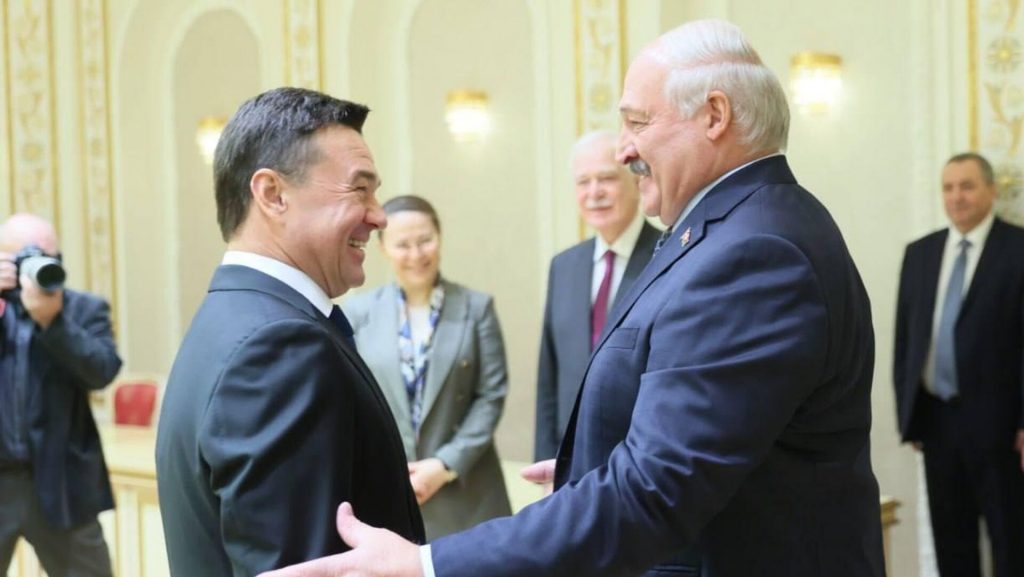
Thus, in almost all meetings with the governors of the regions of the Russian Federation, they talked about cooperation, the creation of joint ventures, the interpenetration of technologies, common standards and the joint search for markets for products. Most of the talk was about cooperation in the military-industrial complex, high technology, agro-industrial complex, tourism and mechanical engineering. 80% of the governors who visited Minsk are in one way or another connected with the head of the Rostec corporation, Sergei Chemezov, which is no coincidence: firstly, we are talking about strengthening ties in the field of military-technical cooperation, and secondly, the Prime Minister of Belarus Roman Golovchenko is Chemezov’s protégé, a native of the military-industrial complex. If, at first, the visits of governors to Belarus were organised by the Administration of the President of the Republic of Belarus, then starting in April 2023, this issue began to be supervised by Chemezov by agreement between the two presidents – Lukashenko and Putin.
Thus, we can say that there is a gradual “creeping integration” of Belarus into a single all-Russian market and a single economic space. In 2014, Lukashenko complained that Russia was not fulfilling its obligations under the single market and the Union State. Now, the absorption process is more active, and integration is becoming more distinct.
At the same time, it is essential to note that starting from November 2023, visits by the heads of Russian regions have almost completely stopped, having lost their regularity. Ascolta sources report that this is due not only to the protracted period of the New Year holidays but also to the presence of severe disagreements, which are significantly blocking the strengthening of cooperation within the Union State. It is possible that the new meeting between Lukashenko and Putin, held on January 29 in St. Petersburg, was organised to find new points of contact and resume integration processes.
It is worth assuming that shortly, an official statement on the final creation of the Union State at all levels may be announced. However, it is essential to consider two key factors influencing this process. Firstly, we are talking about the parliamentary elections in Belarus, which are due to take place on February 25. The main question is whether Lukashenko will agree to carry out all the necessary procedures through the old parliament, which will lose its legitimacy in a month, or will he prefer to shift this responsibility to the new parliament. Secondly, we are talking about Putin’s desire to demonstrate another “big victory” on the eve of the presidential elections, which will take place on March 17.
